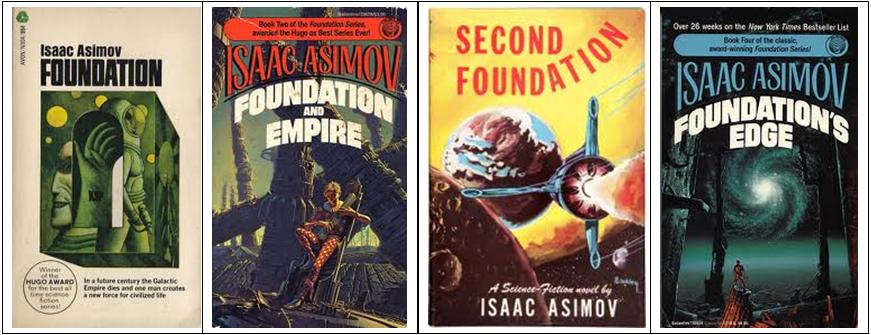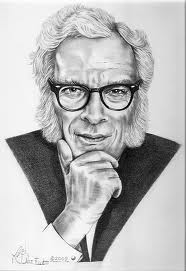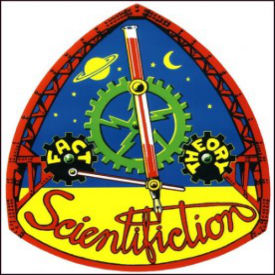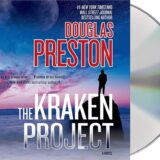2013Feb24 Isaac Asimov, Psychohistory, Robot Crimes, and Positronic Brains.
Isaac Asimov, aka: Isaak Yudovich Ozimov, aka: Исаак Юдович Озимов, is another member of the Big Four of the Golden Age of Science Fiction.
In a sense, I think of Asimov as the Grandmaster of Science in Science Fiction. He has the science credentials (a doctorate in Biochemistry and full professorship at Boston University) and his published works of non-fiction to fiction are roughly equivalent, both in numbers and impact.

I can be a jealous creature, sometimes resentful of the accomplishments of others. I suppose this is true of how I feel about Asimov since I’m compelled to acknowledge that he was an absolute genius (sigh).
I’ll understand if you don’t like him. He has, after all, sucked all the ink out of his contemporaries’ pens in his publishing fervor. Anybody who has a confirmed count of ~470 published works, with a team of ongoing bean counters pushing that number over 500, is bound to make enemies. Possibly, this is justification for enmity — all in itself.
“The saddest part of life right now is that science gathers knowledge faster than society gathers wisdom.” –Isaac Asimov
Then again, so many of his works are a good read. One of my first collections of his was non-fiction: Understanding Physics: Volumes 1, 2, & 3. This was quite handy in my college science class: Physics for Poets. As the course name implied, it was not intended for majors. Still, Asimov’s books were a handy supplement since the regular course textbooks weren’t as fun to read.

But we think fiction is his real legacy, now don’t we? Since he’s best known for his Foundation series, I’ll briefly summarize.
The Foundation Series (7 novels) – Prelude to Foundation, Forward the Foundation, Foundation, Foundation and Empire, Second Foundation, Foundation’s Edge, and Foundation and Earth. special Hugo Award for “Best All-Time Series.”

The protagonist, Hari Seldon, is a psychohistory mathematician—psychohistory being a type of predictive science based on the sociological behaviors of the human race. Seldon predicts the fall of the galactic empire, followed by a dark age that may last either 30,000 years, or possibly only 1,000 years –if humans do the right thing.
In preparation for this future dark age, Seldon sets up two secret foundations, holding all humankind’s knowledge on opposite sides of the galaxy. One focuses on physical sciences, the other on mental sciences. A mutant, The Mule, seeking galactic conquest, tries to destroy the foundations, but fails. However, the physical foundation feels threatened by the mental and tries to destroy it. The mental foundation sacrifices 50 members as martyrs in order to reclaim their anonymity.
Two additional series insinuate into this main series: The Robot Series and The Empire Series. They rely upon the same fictional world as The Foundation Series, increasing the series total to fourteen novels. At some point, Asimov began unifying The Foundation Series. Consequently, a reader may note some discrepancies within these works.
This brings us to the subject of Asimov and robots. The U.S. Congress acknowledged Asimov’s contributions to science by passing a resolution (2010Mar09 – House Resolution 1055) in: “supporting the designation of National Robotics Week as an annual event. This, incidentally, validated Asimov’s assumptions underlying The Three Laws of Robotics. The Three Laws are:
1) A robot may not injure a human being or, through inaction, allow a human being to come to harm.
2) A robot must obey the orders given to it by human beings, except where such orders would conflict with the First Law.
3) A robot must protect its own existence as long as such protection does not conflict with the First or Second Laws.
There’s a fourth law, called the zeroth, that precedes the others:
0) A robot may not harm humanity, or, by inaction, allow humanity come to harm.
However, one writer has pointed out that even within Asimov’s own stories, there are as many as twenty-nine variations of these laws. And Asimov’s influence drew other writer’s into the fold of the Three Laws.
Several works about robots are worthy of the attention of readers new to Asimov’s works: Robot Dreams, Robot Visions, The Complete Robot, The Rest of the Robots, The Caves of Steel, The Robots of Dawn, Robots and Empire, I, Robot, and The Bicentennial Man; all of these works address concepts about robots and their impact upon humans, in both a personal and sociological sense.

In I, Robot, a self-aware robot becomes the subject of an investigation into a murder … the murder of his creator, in fact. His vindication is essential: for himself, for an entire class of robots, for the future relations of humans and robots, and for uncovering the truth of who is really behind the murder.
The Caves of Steel is a delicious blend of SF and detective story where Elijah Baley, a NY policeman, and R. Daneel Olivaw, a humanoid robot, are first introduced. They are dispatched by the police commissioner to investigate the murder of Space Ambassador, Noj Nemmenuh Sarton. Key to the story are the debates between the human and the robot, who eventually proves he has a good grasp on morality.
The Naked Sun is a redux of Baley and Olivaw, this time the murder hinges on whether a robot knowingly allows a human to come to harm. It is a deliberate misinterpretation the two investigators must unravel.
The Robots of Dawn teams up Baley and Olivaw on the Spacer world of Aurora where they must investigate the “Roboticide” of R. Jander Parnell, a humaniform robot on the staff of Gladia Demarre. Interviews reveals that Demarre’s sexual relation with Jander ran deep … and she is not the only human having sexual relations with robots. Both the nature of psychohistory and positronic brains emerge in this novel’s storyline.
Robots and Empire continues the exploits of Olivaw, now accompanied by R. Giskard Reveltlov, after Baley has long expired. Gladia Demarre is still around and the galaxy has expanded under a new wave of colonizing expansion. Olivaw and Revetlov are hampered by the Three Laws as they attempt to prevent a plot to irradiate the Earth and make it uninhabitable.

The Positronic Man, a novel (written with Robert Silverberg), is an reinvention of the The Bicentennial Man, a novella by Asimov. As the robot, Andrew, develops, his creative processes take over and he evolves into a sentient being. But the legal ramifications of his immortality sparks jealousies in humans and longing within the robot. Feelings, then, are not the exclusive reserve of humans, but the legal right to being a part of humanity is. Andrew is given a choice; to be recognized as a human, he must abandon his immortality.
Asimov’s works shape the views of many SF writers including Gene Roddenberry. In Star Trek: The Next Generation, Data results from Asimov’s concept of a positronic brain; the foundation of Data’s cognitive matrix.
Data, is put on trial in The Measure of a Man (teleplay by Melinda M. Snodgrass). One character sees Data as just a machine and we discover that Data has a storage capacity of 800 quadrillion bits and a linear speed of 60 trillion operations per second. This, and the fact he can be turned off, seems to invalidate his claim to sentience.
His humanity is brought into question. Is he a disposable person? If others are created like him, are they to be employed in the capacity of a slave? Consciousness becomes a legal argument for bestowing rights and a life of self-determination. This decision will effect the future psychological development of humans. The moral issue, then, becomes whether the creation of life is valid only for human procreation.
Astute readers might consider the meaning of all this. A fictional environment defining the public perception of what makes us human? Have our definitions of life, and human rights, been modified by this man’s musings? What impact have concepts of humanity been affected by our concepts of robots and their “human rights?” I am reminded of Jimmy Carter. Internal missives of the KGB in the former Soviet Union thought “Jimmy” was the biggest threat they’d ever faced. The Helsinki Accords affirmed “individual human rights” and challenged Soviet concepts of “collective rights.” Has our humanity been shaped by the fictional rights of fictional beings. Once imagined, forever true?
The original Asimov Award is now known as the Dell Magazines Awards. In 1994, the Committee for the Scientific Investigation of Claims of the Paranormal (CSICOP) –now know as the Committee of Skeptical Inquiry— began awarding the Isaac Asimov Award: “to honor Asimov for his extraordinary contributions to science and humanity.” In 1998, the American Humanist Award bestowed its first Isaac Asimov Award.














Thanks for the informative comment. I've been interested in collaborations for some time, actually.
I picked up Technical Writing Certificate from Dr. Kenneth Price. One of his more pointed remarks was about collaboration. You spend most of your college career working alone (students in college hate sharing grades), but when you get into the REAL world, collaboration is the norm. Most of us haven't got a background in the training or the experience with collaboration.
Everything I've read points to the importance of understanding who is going to do what in a collaboration. My own experience has proved this is true. Bad things happen when you don't make things clear in the begining. One thing that helps is previous experience, of course, but where do you get it? Well, … sometime you have to take risks. When it works, great things can happen.
Thanks for your interest.
Screenplay writers do lots of collaboration, but also pick up where other writers have finished.
That was an interesting link. Once again, the site has a great cover art collection of Asimov's works. Great link.
Interesting. I didn't know that about his 17k/day. I'm not surprised. If I was going to describe his condition, it would have to be something like graphophiliac. the man couldn't stop writing.
You mentioned collaborations. There can be many types. One of the most widely published authors of mystery fiction did an interview with CNN. In the article he outlined how most of his books are ghost written. He writes an outline, hands it off, the other person writes the book, and then he reviews it and offers structural editing.
Another common type I know of is where the author writes the work, and then a second author takes it over to "polish" it. This is obviously common in the film industry. Check out the writing credits and the use of "and" versus "&". The writer's guild of America has many rules regarding credits and how many times you can rewrite a work.
In the case of Nightfall, my sheer speculation is that Siverberg took the original work and made it into a novel. Possibly Asimov came through later to read it and offer comments.
Look forward to your next post.
RKT
Yes. I meant John Campbell. Sorry for the error. Thanks for catching it.
R.K.
You're so right about his brilliance. I freely admit that I feel diminshed in his presence. I struggle with my writing, worrying over my sentences and structure. Asimov wrote so much, I don't imagine that he had much time for editing and living. Plus he managed to keep his writing readable by the average Joe and Joan.
I think every writer likes to think their work gets better over time (well, it should, one would think). But sometimes a writer's youth has a clarity of vision unencumbered by later demands of one's professional aspirations.
Robert Silverberg also helped write The Bicentennial Man,, but I have to wonder how they manage to do that. Collaborations that work aren't common. I'm also curious about your comment about Joseph Campbell (Hero with a Thousand Faces). Did you mean John W. Campbell, the editor of Astound Science Fiction magazine? John Campbell wrote with both Asimov and Heinlein. I hadn't heard about his interaction with Joseph Campbell.
Curious…
JJayJ
Asimov was a great. One of my favorite science fiction authors. I was told that near his death he was writing around 17k words per day and every word was published. Many, including msyelf, think his best work was his short story "Nightfall". (Later made into a novel with Robert Silverberg.) Asimov disagreed with this idea since it was written when he was 18, and the ending was reportedly given to him by Joseph Campbell. None of us want to think we did our best work when we were 18.
Anyone that hasn't read any Asimov, I would recommend starting with the original Foundation series. He was not only a briliant man, but a very gifted writer.
Thanks for the post.
Useful link:
https://www.fantasticfiction.co.uk/a/isaac-asimov/